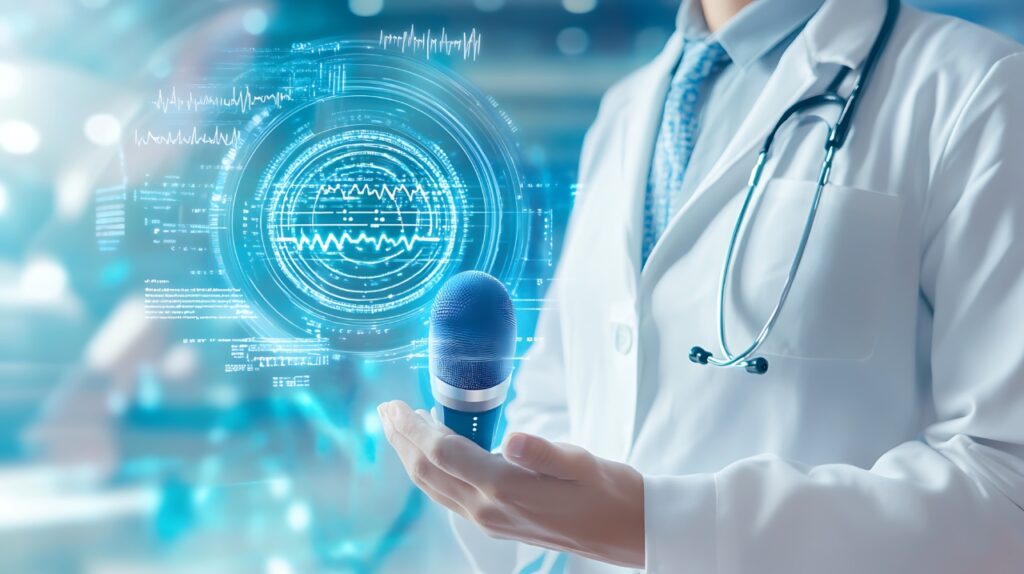The global generative artificial intelligence (AI) market size is predicted to grow almost nine times between 2024 and 2030, reaching an estimated $356.05 billion. In healthcare, generative AI has given rise to ambient documentation solutions. Those are the tools that assist clinicians in their interactions with patients. A doctor talks to a patient and conducts all necessary tests, and the tool automatically records the conversation and compiles a clinical note afterward. Therefore, clinicians stay focused and do not distract their attention from patients by typing data.
Speech recognition software allows physicians to release themselves from the burden of documentation and have all the necessary clinical data at their fingertips. Such systems switch between taking notes and performing voice commands, minimizing documentation errors and modernizing the health systems infrastructure overall.
In this post, the Belitsoft company that develops custom medical software for healthcare tech startups in the USA shares its expertise regarding voice recognition systems, their benefits, and features.
Medical Documentation Obstacles
Vendors offer a variety of turn-key solutions for their customers. However, their functionality differs and is not always sufficient to meet clients’ expectations. Here is a list of the possible workflow efficiency and accuracy limitations with legacy speech recognition software:
- Absence of bi-directional integration with an electronic health record (EHR) system. It allows users to leverage the EHR data to generate the note and, vice versa, transfer the note back to the EHR to complete the fields.
- Necessity to exploit manual work to check and edit notes before submitting them to the EHR. As a result, additional friction in the clinician’s workflow arises.
- Delayed processes of submitting the notes to the EHR. As reviewers need time to check the details, notes do not appear in the EHR in near real time.
- Security and privacy risks. Delegating the notes editing process to reviewers means they access patient-sensitive data.
- Unacceptable accuracy for medical dictation available with current products on the market.
- Difficulty finding a balance between speed and accuracy of the solution. Slow but accurate tools add to doctors’ stress levels just as much as fast but less accurate tools.
- Finding a solution that would cover various aspects of physicians’ routine. Doctors need an assistant for real-time voice recording, comprehending medical context, and handling commands.
- Absence of a solution with a seamless transition from processing commands to transcribing dictations. Doctors need an unobtrusive tool to aid them naturally in efficient patient care provision.
- Sensitivity to voice variability and speed of speech. Doctors have different accents, tones, and voice pitches. Besides, transcribing quickly changing text in real-time may result in inaccurate notes.
- Poor internet connection or low fidelity microphone. Technical issues influence the quality of recording and transcribing texts.
AI-featured Healthcare Voice Recognition Software Functionality
In a nutshell, voice recognition tools serve as invisible digital assistants to doctors. Their main aim is to allow doctors to interact naturally with their patients and deal with diagnosis and treatment plans instead of fulfilling tiresome administrative documentation. The software offers the following functionality:
Workflow adaptability and supportive features
- Adapt to different workflows and recognize various clinical specialities, from surgery to behavioral health.
- Assist clinicians by specialty-focused ambient prompts regarding peculiar details and medical terms specific to their workflows, whether they are psychologists or surgeons.
- Perform both dictation transcription and voice commands to help physicians deal with documentation faster.
- Recognize when a doctor switches from dictation mode to commands by analyzing a user’s navigation events, focus on various sections, and cursor movements.
- Tackle a broader set of tasks, such as coding, finding data in the EHR, answering inbox messages, and so on.
- Understanding the country-specific healthcare environment context.
Data integration and accuracy features
- Incorporate a large language model (LLM) to learn from a patient’s previous data, such as health history, to assist doctors in creating notes.
- Provide two-way integration with EHR, allowing relevant data from it to be utilized in creating notes and enabling the completed notes to be seamlessly uploaded into the appropriate fields.
- Address relevant patient information, such as previous health history, latest vitals and test results, and other contextualization factors while generating notes.
- Create a note trial to prevent data loss when clinicians dictate at various times throughout the day, especially if the internet connection is slow or microphones are of poor quality.
- Compile patient summaries to allow doctors to prepare for patient admits by capturing data from previous emergency department (ED) visits or inpatient stays beforehand.
Organizational Measures for Smooth Software Implementation
To benefit from any software, careful implementation of this software is just one step. It is also critical to take some additional actions.
Clinicians should be trained to operate the software and to know how to edit, accept, and reject generated notes.
It is important that all the notes in the system should be standardized. However, each doctor has their own style of documenting content. Changes and corrections might be performed either by typing or by providing oral commands. Clinicians should be aware of this.
In the case of tools that require manual review of the AI output, healthcare systems should take care to secure access to patient-sensitive data.
Benefits and Impact of Voice Recognition Software in Healthcare
Voice-to-text products are said to bring the following benefits to healthcare systems:
- Clinicians spend 72% less time on documentation, 79% of responders emphasize better documentation quality, 70% feel less fatigue and burnout, while 81% of patients reported greater physician focus, according to the American Academy of Family Physicians (AAFP) study.
- Users have a single, convenient interface for the dictation process, queries, and commands.
- A broad range of specialists can utilize the ambient solutions in their workflows, as the models are trained on vast arrays of data.
- Doctors conduct natural conversations with patients and colleagues while making diagnosis decisions and do not waste time typing and clicking.
- The scalability of the software allows healthcare organizations to avoid implementing multiple solutions and as a result cut costs on training staff and maintenance.
How Can a Healthcare Software Development Company Assist?
Healthcare software development companies like Belitsoft provide healthtech startups and data analytics companies with expert assistance in crafting custom software solutions like data analytics platforms. These tools enable users to improve performance metrics by addressing gaps in workflows.
Integrated data platforms perform functions such as collecting, storing, handling, and examining large volumes of information from sources like electronic medical records (EMRs), clinic management systems, laboratory systems, billing systems, etc., allowing them to cope with the following tasks:
- Automate operational processes, such as cleansing, standardization, and normalization.
- Establish scalable data repositories.
- Implement analytical tools for creating dashboards, reports, and visual data representations.
- Configure data protection algorithms and adhere to healthcare regulations such as HIPAA.
- Integrate machine learning and AI into analytics.
Healthcare software development companies are also ready to create specialized software like voice recognition for:
- Generating notes in real time following doctors’ voice transcription.
- Automatic distinguishing between a voice command and dictation mode for a seamless transition between the two.
- Synchronization of doctors’ notes with internal systems, EHRs, etc.
- Customized note sections for doctors to easily look through the data in such locations as medication history, pediatric sleep, health maintenance, etc.
- Embedded note templates tailored to doctors’ personalized experiences and preferences.
- Integrated ICD-10 diagnosis codes to enable easier coding and billing procedures.
- Compliance with security protocols to align with the health system’s requirements.
- Multi-language interface to avoid translation.
- Augmentation with a Google Chrome extension that helps to conveniently create notes.
For those seeking expertise in areas including analytics infrastructure, HL7 interfaces, workflow engineering, cloud-based developments spanning AWS, Azure, Google Cloud environments, and hybrid or on-premises setups, Belitsoft offers outsourced expertise tailored to meet specific needs.
Caroline is doing her graduation in IT from the University of South California but keens to work as a freelance blogger. She loves to write on the latest information about IoT, technology, and business. She has innovative ideas and shares her experience with her readers.





![‘Frankenstein’ Review – Guillermo del Toro’s Definitive Look At The Nature And Nurture Of Monstrosity [TIFF 2025] ‘Frankenstein’ Review – Guillermo del Toro’s Definitive Look At The Nature And Nurture Of Monstrosity [TIFF 2025]](https://cdn.geekvibesnation.com/wp-media-folder-geek-vibes-nation/wp-content/uploads/2025/10/Frankenstein-175_PF_20240430_20377_R-300x200.jpg)
![‘Wake Up Dead Man: A Knives Out Mystery’ Review – In Rian Johnson We Trust [LFF 2025] ‘Wake Up Dead Man: A Knives Out Mystery’ Review – In Rian Johnson We Trust [LFF 2025]](https://cdn.geekvibesnation.com/wp-media-folder-geek-vibes-nation/wp-content/uploads/2025/10/Wake-Up-Dead-Man-A-Knives-Out-Mystery-300x169.jpg)